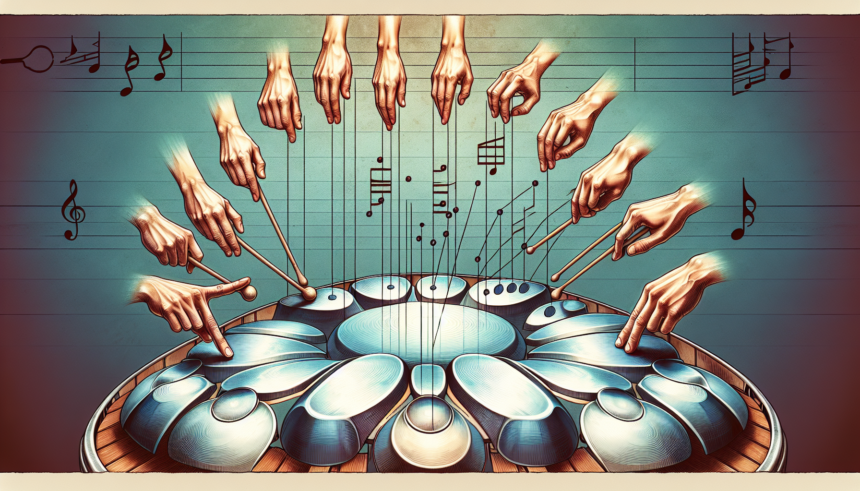The handpan has captivated musicians and music lovers alike with its ethereal and resonant tones. This relatively young percussion instrument, invented in the early 2000s, offers a unique blend of melody and rhythm. Over time, the techniques used to play the handpan have evolved significantly, transforming from basic tapping to highly sophisticated and intricate patterns. This article explores this evolution, delving into the foundational techniques before advancing to more complex skills.
Basics: Discovering the Instrument
When introduced to the handpan, most beginners are eager to produce its signature harmonious sound. Initial lessons often focus on hand posture, striking techniques, and the instrument’s layout. The handpan, usually shaped like a convex UFO, has different tone fields on its surface, each corresponding to a particular note.
The initial tapping techniques involve using the fingertips and the heel of the hand. These methods are crucial for producing clear, resonant sounds. A gentle touch is necessary because striking the instrument too hard can produce harsh, unpleasant tones. Additionally, players learn to control the duration of each note by adjusting the pressure and speed of their strikes.
Intermediate Skills: Exploring Rhythms
As players become more comfortable with the basic techniques, they start experimenting with rhythms. The handpan’s design allows for the creation of rhythmic patterns that can be both complex and mesmerizing. Intermediate players often focus on developing a steady tempo and learning to switch between different rhythms seamlessly.
At this stage, musicians begin exploring polyphony – the playing of multiple notes simultaneously. This requires a higher level of hand coordination and precision. This technique opens up a new world of musical possibilities, enabling players to create a fuller, richer sound.
Advanced Techniques: Mastering the Instrument
For those who reach advanced proficiency, the handpan becomes a canvas for intricate and expressive artistry. Advanced players employ sophisticated techniques such as muted notes, ghost notes, and harmonics to create complex soundscapes. These techniques require meticulous control and a deep understanding of the instrument’s acoustics.
Muted notes involve touch without full strikes, producing a sound that is softer and more subtle. This technique is often used to add texture and variety to compositions. Ghost notes – faint, almost inaudible notes – provide a rhythmic foundation, enhancing the overall complexity of the music.
Harmonics are another advanced technique, where players strike the handpan at specific points to produce overtones. This creates a shimmering, crystalline sound that adds depth and richness to the performance.
Evolution of Playing Styles
The evolution of handpan tapping has also seen the emergence of distinct playing styles. While some players focus on meditative and soothing compositions, others explore fast-paced, energetic playing. This diversity in styles reflects the versatility of the handpan and its appeal to a wide range of musical tastes.
Influences from other musical traditions have also enriched handpan playing. Flamenco, jazz, and world music elements are often incorporated, leading to innovative and hybrid styles. This cross-pollination of genres has expanded the boundaries of what can be achieved with the handpan, pushing players to continuously evolve their techniques.
Community and Sharing
The handpan community has played a significant role in the evolution of playing techniques. Online platforms, workshops, and festivals provide spaces for players to share knowledge and inspire each other. Collaboration and collective learning have accelerated the advancement of handpan skills, making the learning process dynamic and communal.
Social media and video-sharing sites have also been instrumental in popularizing advanced techniques. Musicians from around the world can showcase their innovations and creative expressions, reaching a global audience. This has led to a democratization of knowledge, where even beginners have access to a wealth of instructional content and inspiration.
The Role of Technology
Technological advancements have had a profound impact on the development of handpan tapping techniques. Enhanced manufacturing processes have resulted in handpans with greater tonal clarity and consistency, enabling players to explore more nuanced sounds.
Digital tools and software have also opened up new possibilities for handpan music. Looping devices, effects pedals, and recording software allow players to experiment with layered compositions and live performances. This fusion of traditional playing with modern technology has greatly expanded the creative potential of the handpan.
Conclusion
The evolution of handpan tapping from basic to advanced skills is a testament to the instrument’s remarkable versatility and the creativity of its players. From the initial discovery of its unique sound to the mastery of intricate techniques, the journey of a handpan player is one of continuous exploration and growth. With the support of a vibrant community and the integration of new technologies, the handpan continues to inspire and evolve, offering endless possibilities for musical expression.
FAQs
- 1. What is a handpan?
- A handpan is a convex steel drum, often shaped like a UFO, known for its harmonious and resonant tones. It was invented in the early 2000s and has become popular for its unique blend of melody and rhythm.
- 2. How do you produce clear sounds on a handpan?
- Producing clear sounds on a handpan involves using a gentle touch with the fingertips or the heel of the hand. Striking the instrument too hard can result in harsh tones. Controlling the pressure and speed of strikes is crucial for achieving a resonant sound.
- 3. What are some advanced techniques for playing the handpan?
- Advanced techniques for playing the handpan include muted notes, ghost notes, and harmonics. These techniques require meticulous control and can add complexity and richness to the music.
- 4. How has technology influenced handpan playing?
- Technology has enhanced handpan playing through improved manufacturing processes, resulting in better tonal clarity. Digital tools such as looping devices and effects pedals have allowed for experimentation with layered compositions and live performances.
- 5. Can beginners learn advanced handpan techniques?
- While advanced techniques require practice and precision, beginners can access a wealth of instructional content through online platforms, workshops, and tutorials. With dedication and practice, beginners can gradually develop their skills and explore more complex playing techniques.





